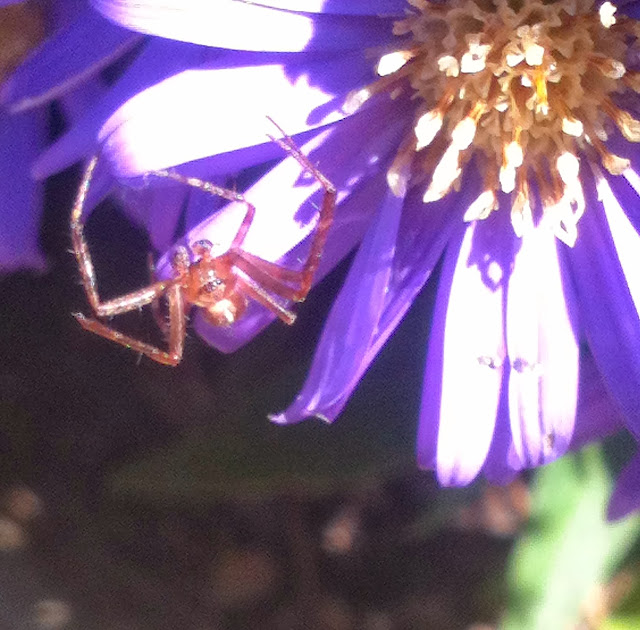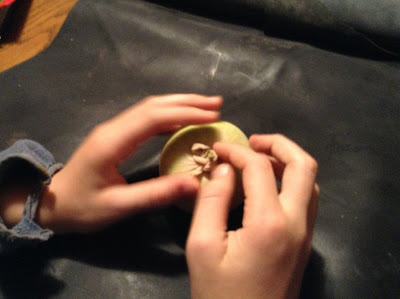So this isn't going to blog about that.
But my naturalist self loves the reproductive things bugs do - and plants, and ducks, and goats and ...
Spiders
They spin less dramatic webs, and in general are less obtrusive. When people see them with females, they often tell me "there's a spider, with a little spider caught in its web", where the little spider is really a male.
 In the fall, the female gets bigger still, as her abdomen plumps up to prepare for babies.
In the fall, the female gets bigger still, as her abdomen plumps up to prepare for babies.The female builds her orb and stays put. This one was hanging out in my greenhouse, cleaning her feet with her mouthparts. Female spiders have a lot of time to hang out, clean up leftover dead bugs, and perfect their webs.
But if both sexes did that, spiders would never meet, and would soon die out.
So the males travel, moving from place to place until they find a willing female and begin their elaborate courtship.
The male in this photo was crossing a single strand of silk to get to the female. She was hanging upside-down with her legs clutched in toward her body. She had swung down from her main web on a strand of her own silk, but he used his own silk to tie all of her limbs up before attempting to mate.
During her entire wait, the female was almost motionless. She neither attempted to eat the male, nor to help him out in any way. Once or twice, she adjusted a couple of legs as though they were uncomfortable, which they might have been, as this whole process took over an hour.
Mating is high stakes to a male spider. Any activity that needs the disclaimer "males of this species are usually not killed while doing this" should be an eye opener. This male was cautious, patient, but determined.
At some point, the male literally got the jitters and kept messing up his web and having to back up and start again. You can't see it in this crumby iPhone picture, but he's missing one front leg. Perhaps he had to learn the hard way that mating is delicate business, although a lot of spiders lose legs along the way. Finally he bound the females mouth parts so she wouldn't bite him, and the action began.
Spiders do not copulate. Instead the male produces a sperm packet which he takes in his mouth and places in the genital opening of the female.
Alas. My camera is also my phone. I wanted to hang around indefinitely peeping on this pair, but I had a call coming in that I had to deal with and I left without knowing whether the female ultimately ate her mate. I think probably not. She had plenty of fruit flies and anyway she seemed more intent on becoming fertilized than on eating.
 Soldier beetles have so much less drama. The three in the foreground are two males and a female. If the male who is connected with the female drops off for some reason, she's got a handy replacement lined up and the other male gets a free ride while he waits.
Soldier beetles have so much less drama. The three in the foreground are two males and a female. If the male who is connected with the female drops off for some reason, she's got a handy replacement lined up and the other male gets a free ride while he waits.Everywhere I looked the day I took this picture, there were more of these beetles, in groups of two, three or more, wandering around, eating and mating and occasionally flying from flower to flower.

Regardless of what its shape may remind one of, a cucumber is female. It is after all the fertilized ovary of the plant.
 |
| Female flower with nascent cucumber attached |
Cucumber plants have separate male and female flowers; only the female has a fruit below the flower.
Pollen can only get from the male to the female flower by some third party - usually an insect.
 |
| ≈Male flower - no cuke |
You can buy seeds for cucumber varieties that are gynoecious - producing only female flowers. You then grow one plant with male and female flowers (monoecius) and the males on that plant pollenate everyone's female flowers.
Or you can grow parthenocarpic cukes where each flower is a self-fertile female. Those seeds are expensive, so I tend to stick with the more old fashioned varieties.
Slugs are hermaphrodites. When they mate, each one fertilizes the other and is fertilized at the same time. Sometimes, one will chew off the other one's penis. It can't grow that back.
It requires patience for a human to watch slugs mating, but unlike with spiders, it is not because one partner is hesitant, but simply because anything slugs do takes time.
Banana slugs dangle from long trails of mucous when they mate. I've seen it and it's cool, but alas Several Gardens' Farm doesn't have any banana slugs.
I have already said all I plan to about the ducks in another postputting-duck-in-reproduction. Male ducks - ugg.

The goats are gearing up for their breeding season. Female goats can get pregnant for a few days every month from September through early January.
They let us know they are ready by bellowing, mounting each other, wagging their tails and rubbing themselves suggestively on inanimate objects.
Lightning has been high energy - and highly motivated by other goats - since she was a few weeks old. She liked play mounting her siblings; it probably (maybe?) has more to do with her high activity level than anything else.
I keep a buck rag in a jar to gauge how serious they are about actually breeding.
The rag smells very strongly of goat - even when they aren't in the mood, the girls are curious and sniff it in preference to food or attention.
But when she is receptive to the scent of a buck, she will immediately start licking her lips, dancing around and otherwise showing her interest.
Perhaps its just as well all these animals are getting energized in the rainy fall. All winter long their offspring - eggs hung in silken sacs, or deposited in the soil, seeds ripening in cucumbers carefully saved and left to become next year's plantings, embryonic goat twins - will grow and develop, getting ready for next spring.
Slugs are hermaphrodites. When they mate, each one fertilizes the other and is fertilized at the same time. Sometimes, one will chew off the other one's penis. It can't grow that back.
It requires patience for a human to watch slugs mating, but unlike with spiders, it is not because one partner is hesitant, but simply because anything slugs do takes time.
Banana slugs dangle from long trails of mucous when they mate. I've seen it and it's cool, but alas Several Gardens' Farm doesn't have any banana slugs.
I have already said all I plan to about the ducks in another postputting-duck-in-reproduction. Male ducks - ugg.

The goats are gearing up for their breeding season. Female goats can get pregnant for a few days every month from September through early January.
They let us know they are ready by bellowing, mounting each other, wagging their tails and rubbing themselves suggestively on inanimate objects.
Lightning has been high energy - and highly motivated by other goats - since she was a few weeks old. She liked play mounting her siblings; it probably (maybe?) has more to do with her high activity level than anything else.
I keep a buck rag in a jar to gauge how serious they are about actually breeding.
The rag smells very strongly of goat - even when they aren't in the mood, the girls are curious and sniff it in preference to food or attention.
But when she is receptive to the scent of a buck, she will immediately start licking her lips, dancing around and otherwise showing her interest.
Perhaps its just as well all these animals are getting energized in the rainy fall. All winter long their offspring - eggs hung in silken sacs, or deposited in the soil, seeds ripening in cucumbers carefully saved and left to become next year's plantings, embryonic goat twins - will grow and develop, getting ready for next spring.
I can hardly wait
 |
| A lover, not a fighter |


















